Burny by Nils-Bro Muller
Burny les Pauls 1980-87
Why Burny Les Paul´s ?.
Because in my opinion they are the best high quality LP´s you can by today, without getting ruined. Off course there are the Tokai´s and Grecos´s, but when you compare features and prices, you will find, that you will get much more for your money when buying a Burny.
This is true from a player’s point of view, but it is not always true from a collector’s point of view. Today Tokai and Grecos are the must collectable, but this may change tomorrow. I have noticed, that in the last year prices have gone up a lot. A year ago on E-bay you could easily buy a plaintop 1983-85 RLG 50 for 350-400 $, today they sell for 700-800 $ and if you want to by one from a dealer in Europe, You will have to pay 800-900 $.
But even if you pay these prices, you won’t find many guitars which give you more value for money.
Just look at what you get:
A solid good quality mahogany back (often 2 piece. But sometimes 3)
A one piece mahogany neck (often with a separate neck cap)
Two piece solid centred, sometimes very nicely figured maple top
Quality Gotoh Kluson style tuners
A nice rosewood board
Thin poly finish
Nickel hardware
Fret binding
Weight around 4.2 kilo
Very good Fernandes pickups
Correct headstock and neck angle
Before I discuss the different models, I will tell a little about myself.
I am 57 years old, and I’m Danish, living in Denmark, north of Copenhagen.
I have been playing guitar since my early teens, professionally while at university and semi prof. later on. Today I’m a semi-amateur guitar player, playing country rock, or backing a Swedish female singer, when not working as a senior advisor for the government.
I have always been collecting, selling and buying guitars, and I have made a lot of mistakes buying and selling original Fender and Gibsons. I have owned original 62 Stratocasters and an original 1959 sunburst Les Paul flametop. I sold that to a band mate in 1968 for what today is equal to 500$, because he was a better lead player than I was!! He still has that Les Paul!!
I have just sold my 1966 Gibson ES 345 and my original 1958 les Paul junior. I used to gig with these guitars, but today they are replaced with a Burny SA 100, a Burny junior and the 1980 FLG 240/150. They are simply better guitars, and for the price of the two Gibsons I can by 10 Burnys, and a new car!!
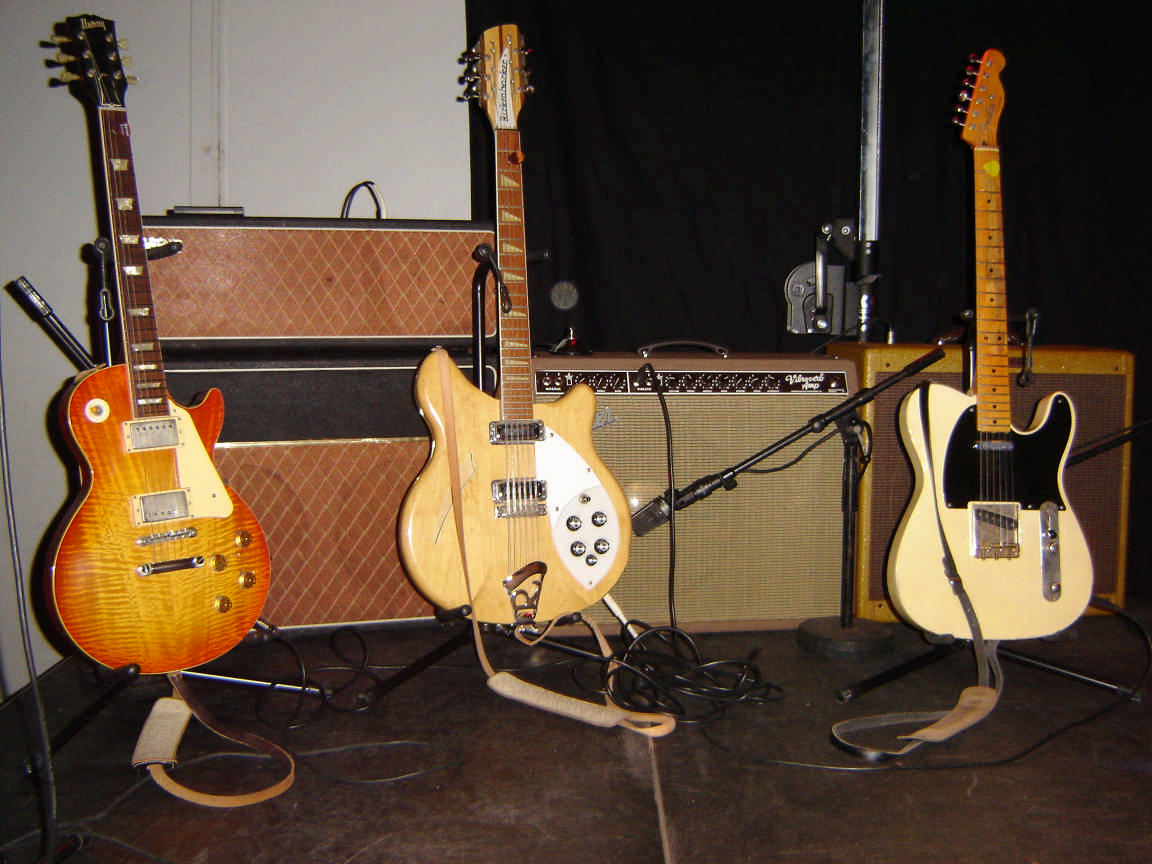
My 1980 Burny FLG 240/150 on stage with my 1954 tele and 12 string Rick.
My Burny knowledge comes from old catalogues, from my own guitars (today I have 10 Burnys and I have owned ca. 25 different Burnys), from discussions with two Japanese dealers and from watching the forums etc. on the www. I must point out, that all observations are my own, and I can’t guarantee anything. The catalogues are difficult to read, and my translations may not be accurate.
Burny Les Pauls history.
Burnys are made by Japanese company Fernandes. The company started making guitars in 1969, and the first Burnys were SG´s, Firebirds and Juniors/specials, they are present in the 1973 catalogue. I have never seen any of these early ones, but from the pictures they look like very accurate copies. The first Les Paul standards are from 1975, and the ones that I have seen are not that great. The hardware (chrome) and the pickups are not very good, and the finish of these guitars is not as good as on the later ones. The top of my 1977-78 FLG 70 is made of 3 pieces of maple, it is the same with the body- 3 pieces, but the mahogany is of very high quality, so the guitar sounds good and resonant unplugged, especially after I have changed, tuners, bridge and tailpiece. These early Les Pauls all have the Les Paul gold script on the headstock, and stamped serial numbers on the back of the headstock.
Thinks changed in 1978/79, where some Fernandes/Burnys where made by Tokai.
In the 1978 catalogue you can still find a Burny FLG-60 with Les Paul script and with Burny and not Tokai features, so something happened in 1978, because there is, as far as I know, no 1979 catalogue, and the only Burny from 1979, I know of, is the Tokai made FLG-60 similar to a Tokai LS-60 “Reborn Old”.
They are similar in many ways except for the name on the headstock. They even have Tokai black inked numbers on the back of the headstock. All I have seen have got 1978 (8oo xxxxx) serial numbers, though they may be 1979 Burnys. In my opinion, this is the first really good Burny Les Paul.
The older ones are just ok, on par with many MIJ Greco’s, Yamahas and Ibanez’s from the same period.
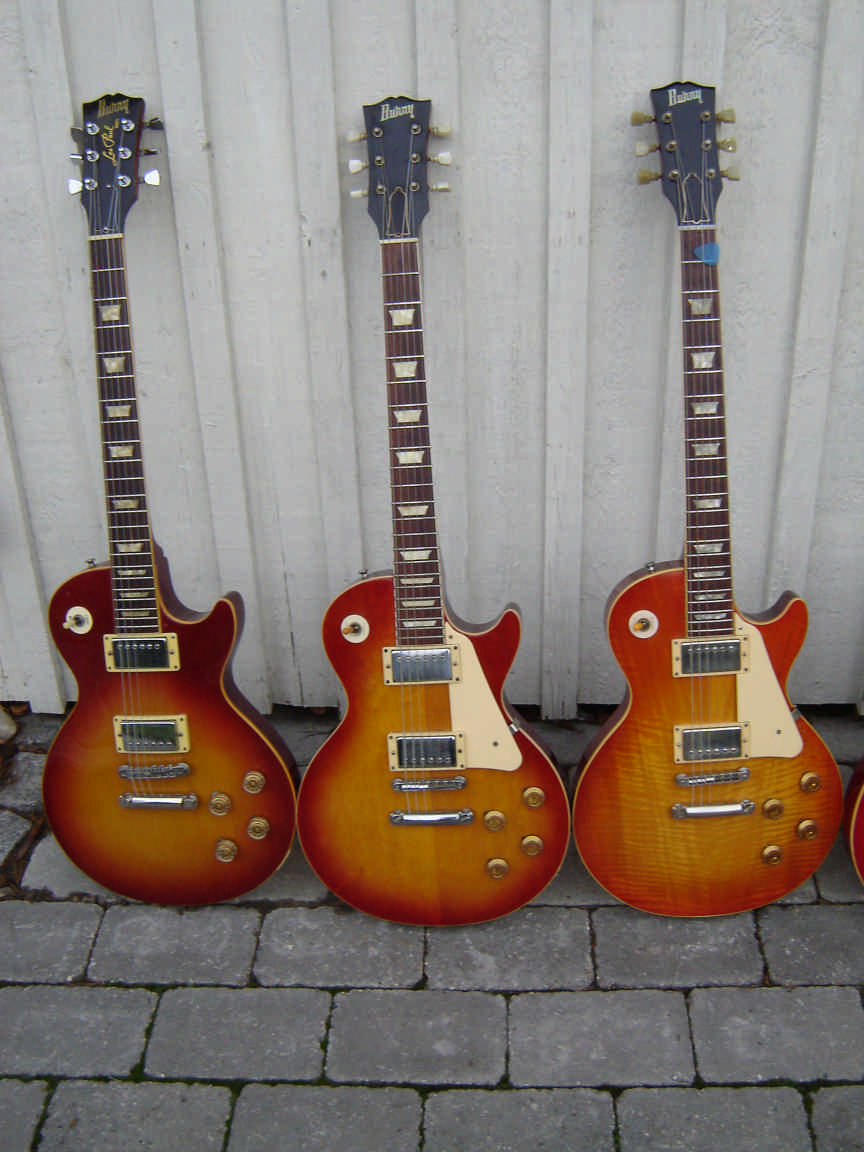
From the left 1977 RLG 70, and Tokai made 1978/79 RLG 60
As you can see from the pictures there is no Les Paul or Super Grade script on the headstock of the Tokai/Burny FLG-60. The FLG-60 have 2 piece back, one piece neck, solid plain 2 piece top and Tokai pearl double ring tuners, and nice double white Gotoh PAF´s. The earlier RLG-70 has Gotoh made Schaller copy tuners, just like Gibsons from the same period.
The Burnys 1980-81.
In the 1980 Fernandes catalogue there was only 3 Les Pauls, the FLG 240 , the FLG 150 and the FLG 90 , no Customs no Juniors . These Les Pauls are in my opinion among the bests ever produced in Japan. The FLG 240 was a special order handbuild guitar with one piece body, one piece neck and solid flamed top, finished in nitro with Duncan 59 pickups and high quality nickel hardware. I’m told that not many 240´s were build, because the production line FLG 150 was just as good, and it had the same features.
I do think, that I have one of the few FLG240´s from 1980.
You could order them, they way you liked them, for example with a special neck or a thinner body than normal. My FLG from 1980 have the thinnest body I have ever seen on a Les Paul only 47.17 mm or 1.85 inch at the end of the body.
I maybe wrong, even original 58-60 Les Pauls had body end thickness varying from 46,6 mm to 48,8 mm, but every other Burny I have seen has a thickness from 48,3 to 48,9 mm, and that is also the normal thickness for the original Gibsons.
(source : Gibson Sunburst Les Pauls From ´58 to ´60 by Yasuhiko Iwanade, Rittot music 1996)
The third guitar from the 80-81 period is the FLG 90. It has solid one piece back but a flamed veneer top and Fernandes L8001 vintage pickups. These pickups looks very much like the later VH1´s and they do sound exactly the same, and in my opinion they sound better than the Duncan 59 PAF pickup. Even the FLG 90 was finished in nitro, but none of them had a real deep neck joint. Some of these guitars have Brazilian boards.
All three guitars have double ring Kluson style tuners, stamped with Fernandes on the back, and they got the Gibson style bell shaped truss rod cover. No script on the headstock and real pearl or pearloid inlays. The electronics are high quality with black paper in oil capacitors and braided wire, like the high end Greco’s from the same period. The switch knob is cream not amber, and the knobs are gold and not amber like the later ones. The guitars have a stamped serial number on the back of the headstock. But they have no other id.
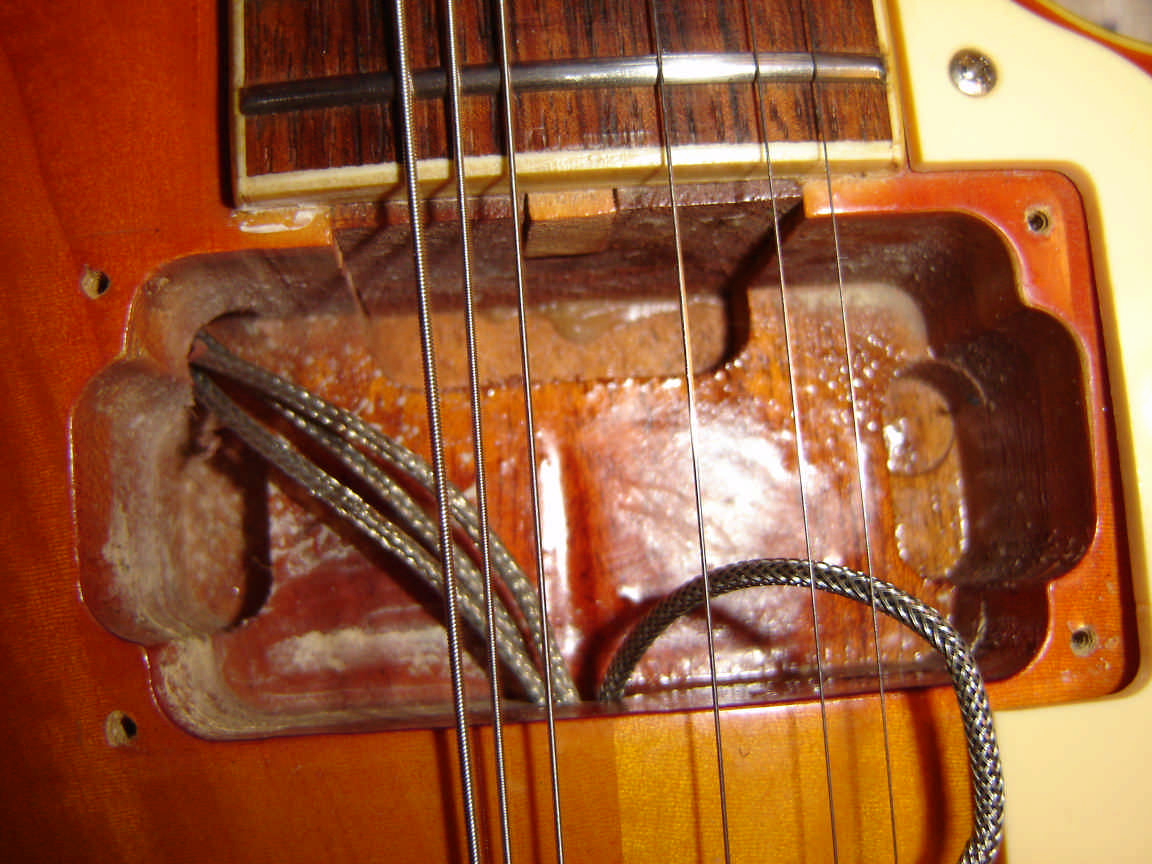
Neck tenon on a 1980 FLG, notice the braided hook up wire.
I’m not sure if these guitars had fret binding, but it looks likes my FLG 240/150 have had it before it was refretted.
There are exactly the same guitars in the 1981 catalogue with the same features, but now they are called The Revival and the have “Super Grade model” script on the headstock, placed exactly the same place as the Les Paul script on the original Gibson. Still no Customs or Juniors.
The big change, the 1982-83 Les Pauls
In the 1982 catalogue something happened. Now there are no FLG´s.
All the Les Pauls are called RLG. There is no RLG 240, but there is a RLG 150, RLG 120, RLG 90, RLG 50, RLG 60 and RLC 60 (custom) and RLJ and RTV 80 (juniors).
The RLG 150 and 120 still have one piece bodies and solid flamed (curled) tops, but now the pickups on these are called L8002 vintage. I can’t tell the difference between the L8001 and L8002 pickups, they look the same in every way, and the resistance is the same, and they sound the same!! The RLG 90 has the L8001 pickups, same as in 1980-81. The RLG 90 still has a veneer flamed top, but now on a two piece centre seamed body, (according to the 1982 catalogue). Colour was ch and coh (cherry original sunburst) today called teaburst.
The Super Grade script is placed a little lower, the “model” is exactly the same high as the G and D tuner. (see pictures).
The RLG 50 and RLG 60 (56. model with P90 type pickups) are new models. The pickups on the RLG 50 and The Custom RLC 60 are the L8000 vintage pickups. These look like the 8001 and 8002, yellow metal base plate and 4 Phillips headed brass screws, but the wire is made of grey plastic and not braided wire like the 8001 and 8002. They also seem to be a little hotter with at resistance over 8.00. The capacitors on the RLG 50, 60 and Customs are ceramic small green ones, and not the black paper in oil ones that are in the RLG 150, 120 and 90.
Now you can hear a difference, and to my ears the difference is the same as the difference between a Gibson PAF and a latter (1967 T stamped) Gibson humbucker. Like the PAF´s the 8002 and 8001 are more open sounding, while the 8000 are more compressed.
The RLG 50 has solid plain two piece tops and two or three piece bodies. All finished in thin poly. Colour was: Original cherry sunburst, Cherry sunburst, Tobacco sunburst, Black and Gold.
The RLG 60 with soapbar P90 pickups was very much like the RLG 50´s and the pickups was called L9000 vintage. The colour on these guitars was gold. The Customs were all mahogany like the Gibsons.
Some of the most accurate Burny replicas are in my opinion the RLJ 80 double cutaway les paul junior. They have got one piece mahogany bodies and one piece necks, with a deep neck joint exactly like a 1958 Gibson Les Paul Junior. The board is really dark rosewood. They even have the same celluloid tortoise pick guard. The headstock is tapered like on all the Gibson’s up to the mid 60´s. The pickups on these are called L9100 vintage! Grey wire, braided hookup wire and black paper in oil capacitors.
1983-1986 Les Pauls
In the 83 catalogue the guitars are exactly the same as in the 82 catalogue, and the pickups are still the L8000, L8001 and L8002 vintage pickups. In this catalogue the VH1 pickup appears for the first time, not in a guitar, but as a replacement pickup. These pickups was rather expensive 12.000 Yen for one pickup!!. No wonder they didn’t put these pickups in the 50.000 Yen RLG 50, but many sellers on E-bay and in Japanese guitar shops still incorrectly call the RLG 50 pickups VH1´s.
In the 1985 catalogue the VH1´s appear for the first time in a guitar. It was in the RLG 150 and RLG 120. There are four new Les Pauls in this catalogue. There are the RLG 60 “59 model” Just like the RLG 50, multi piece back, but with a flamed veneered top.
Two other new guitars are The RSC 100 a black custom with a “Floyd rose head crasher” Tremolo and the RSC 80, cherry sunburst no vibrato. Both have a kind of ES 345 inlay on the board, and both have speed knobs. They have VH2 pickups.
The last new guitar is the 3 pickup Custom RCL 65, same as the RLC 60, but only in black and it is called the “57 model”. This guitar has VH4 pickups. The RLG 90 and RLG 60 had VH2 pickups and the RLG 50 and RLC 60 VH4 pickups. I do think that all guitars are finished in poly.
The RLG 150 and 120 from this period may have a RLG120 or RLG150 stamped in the front pickup cavity
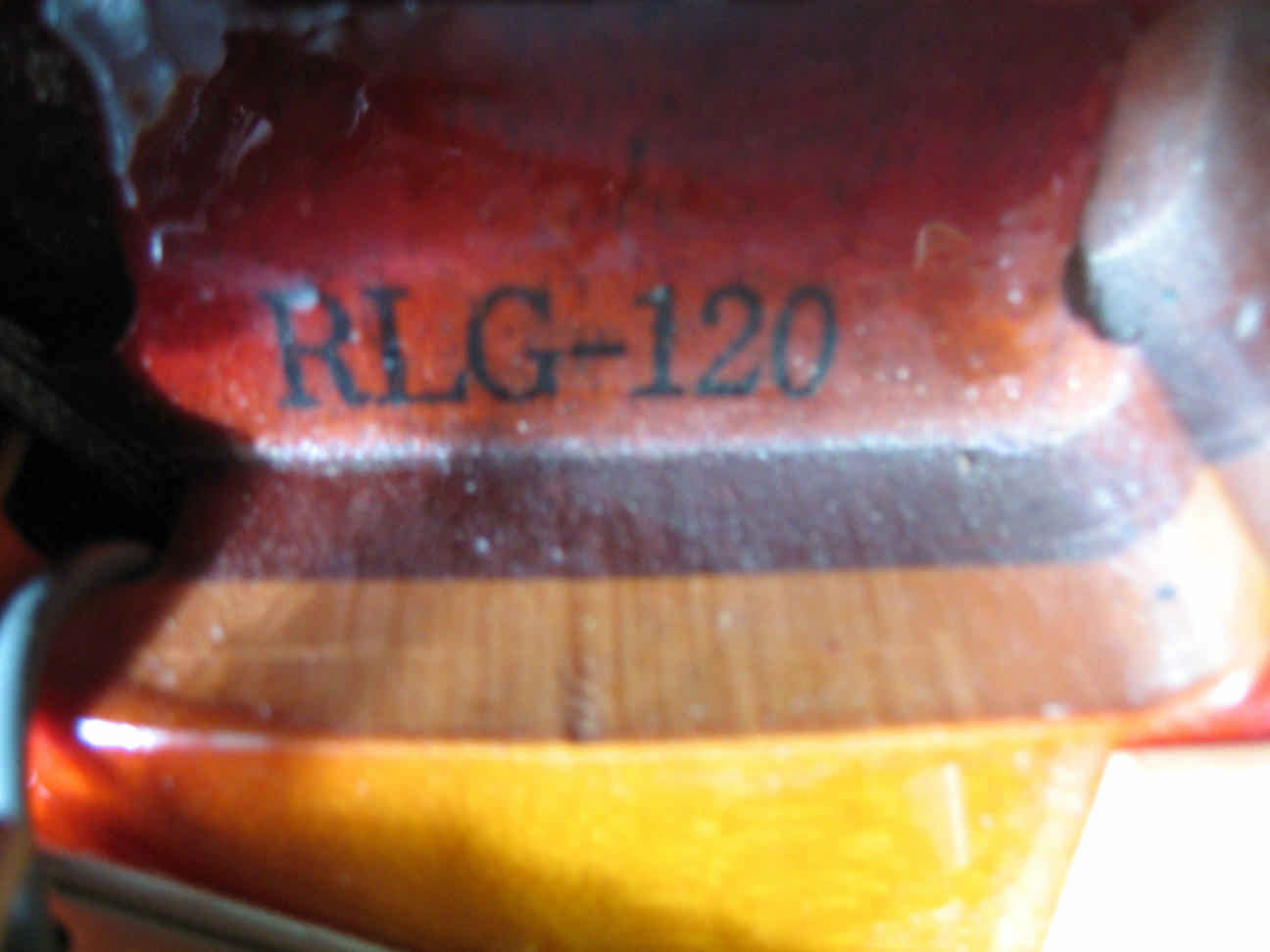
The difference between the RLG 150 and 120 was the quality of the top. Some 120 was made with a laminated maple top. Not the usual veneer, but a thick piece (1 centimetre) of flamed maple on top of another piece of maple, and some of the pickups in the last 120´s may have been Greco “ Screamin' ” pickups.
After 1987
I believe that the FLG 150, 120, 90 and RLC 100 and 80 all disappeared between 1986 and 1987, and the junior was in 1987 called TV 55 and JR 55 with multi piece bodies and lover grade electronics. I do think that the new truss rod cover with the wings first appeared in 1988 and at the same time all the pickups were called VH1´s, but they were different from the old VH1´s, higher output and metal coloured base plate with grey wire. They sound much like the old VH2 –VH4.
The last of the original MIJ Burnys was made in 1995/96 and in this period there was RLG 70, RLG 75 and RLG 80 more or less the same guitar with the same pickups and features often three piece backs and flamed veneered tops. Some cherry sunburst but many faded or tea burst in poly.
The neck on these guitars is always a true one piece, no separate heel cap as on almost all the older ones.
Identification
If you want to identify your Burny Les Paul standard, there are many characteristics you have to study. I will end this paper with the most obvious, the headstock, the pickups, the electronics and the serial number.
Off course there is the colour, the amount of pieces of wood, the quality of the top, the routings, the inlays and the neck joint to consider, but the features I have described in details should give You a god idea, how to date Your guitar and to decide what model it is.
But remember my observations are only guidelines. There are transition models, and it is very easy to change a truss rod cover or a pickup. I have seen a lot of guitars on e-bay with almost anything changed, and the descriptions are often very misleading. But the good thing is I have never seen a bad Burny guitar. I have seen guitars that needed adjustment, cleaning, new frets and so one, but after this they all were fine players with great workmanship, and with great sounding pickups. Some will prefer the VH4 over the VH1 pickup; it depends of music style etc. Remember that these guitars were built in the same factory as the Grecos and Orvilles. Sometimes You will find a (later) Burny with Greco or Orville features but most often they have there own characteristics.
Often the sellers of these guitars don’t know what they sell, and I hope this paper can help anybody, who wants to join the MIJ Les Paul brotherhood. It´s funny importing old guitars from Japanese guitar dealers, watching Yahoo Japan and E-bay and participate in the Tokai and Japanaxe forums on the web.
Headstocks in detail
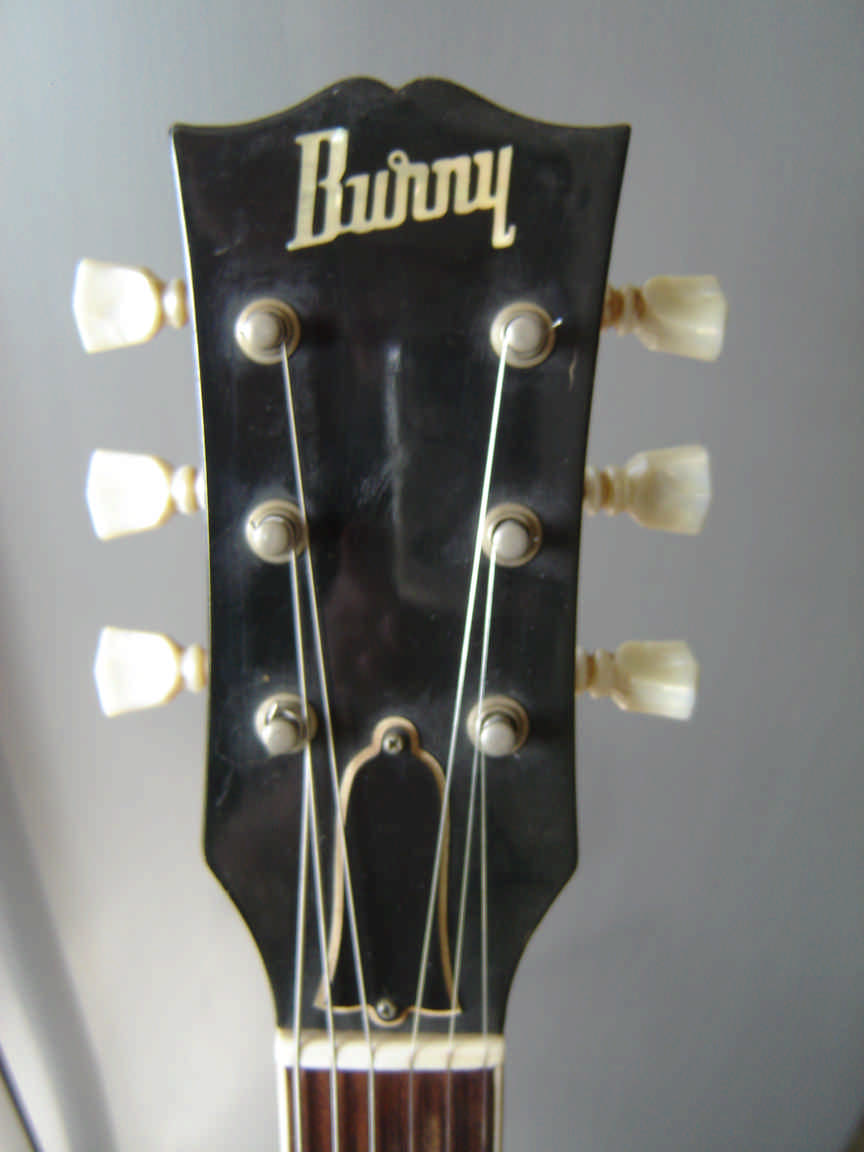 |
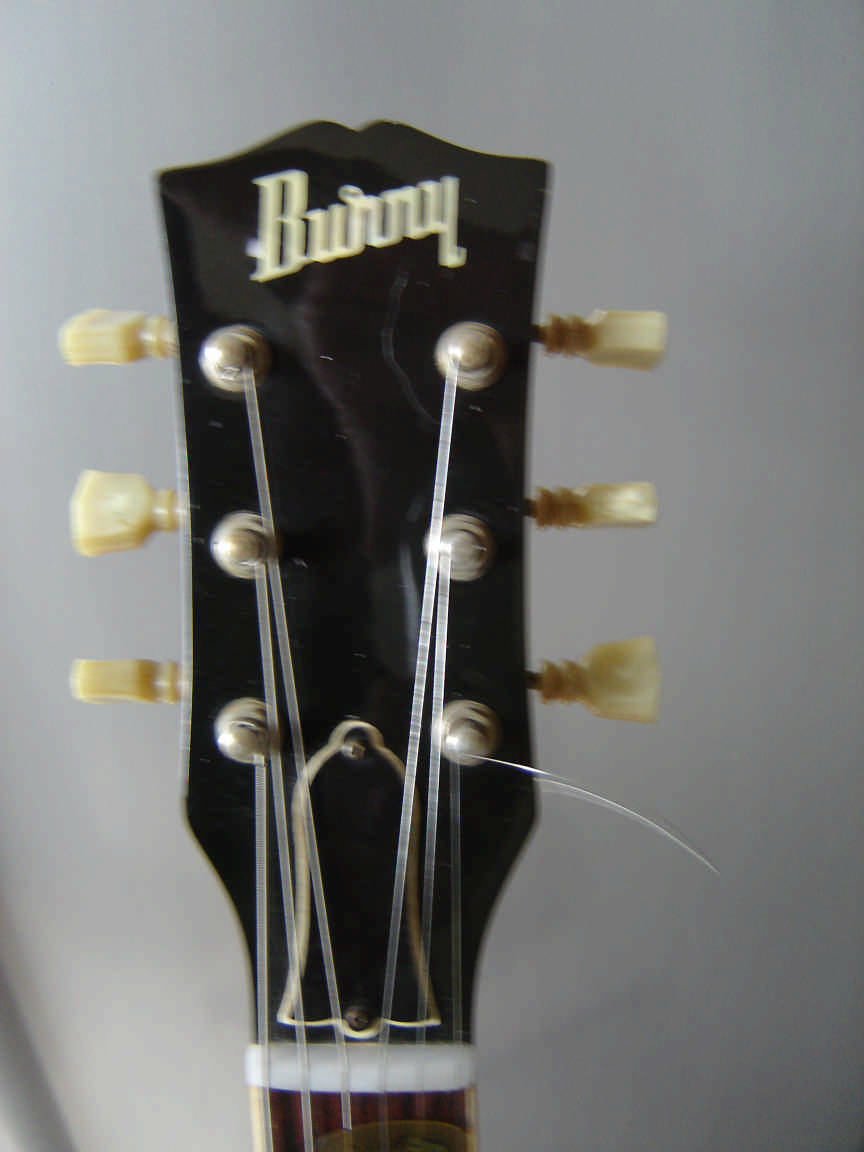 |
|
1979 Tokai/Burny
Pearl Double Ring Tuners No Script |
1980 Burny FLG Fernandes Double Ring Tuners No Script |
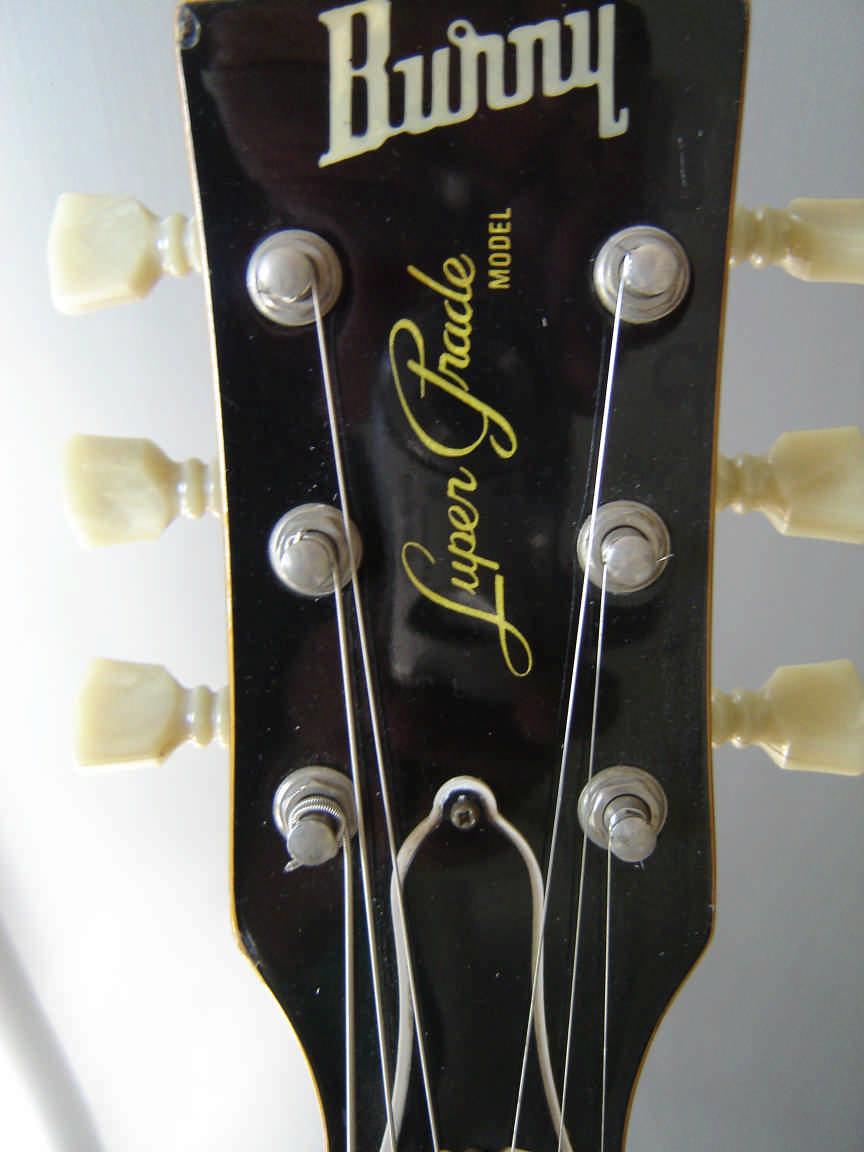 |
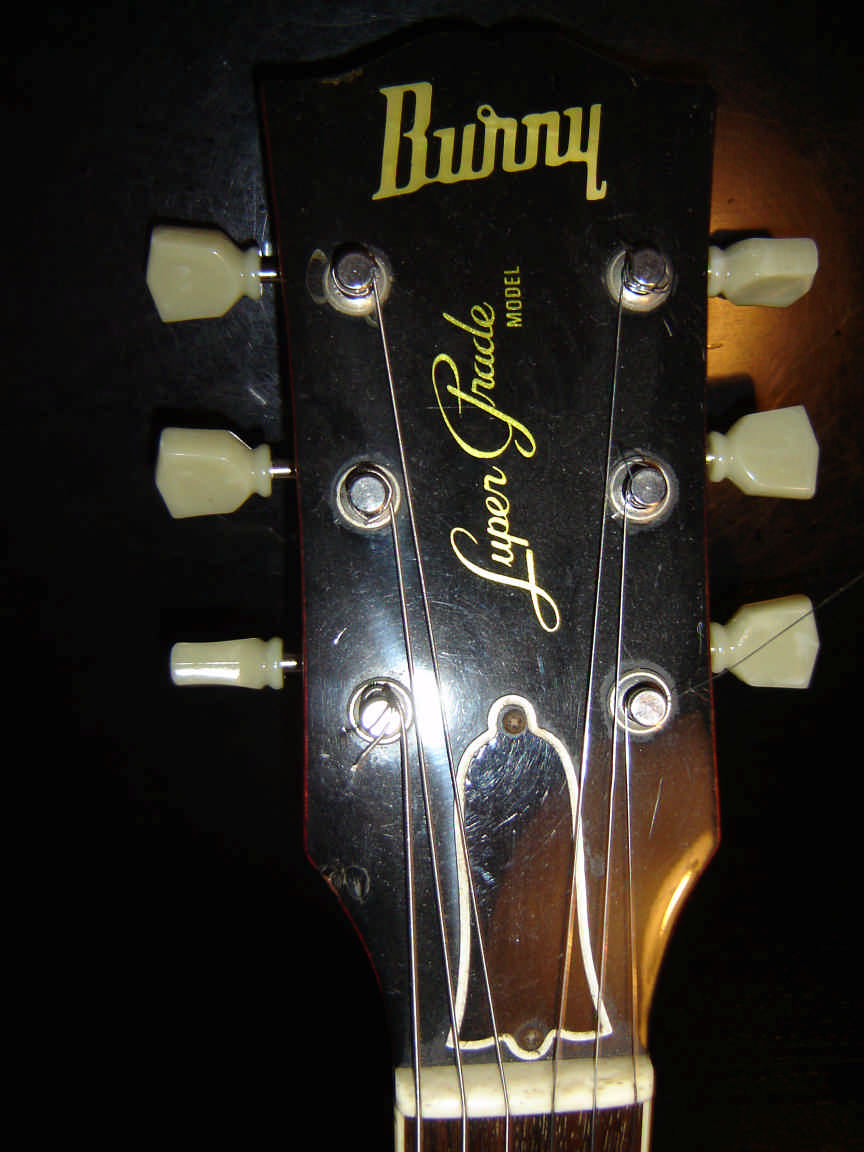 |
| 1981 FLG Fernandes Double Ring Tuners High Script |
1983 RLG Single Ring Tuners Normal Script |
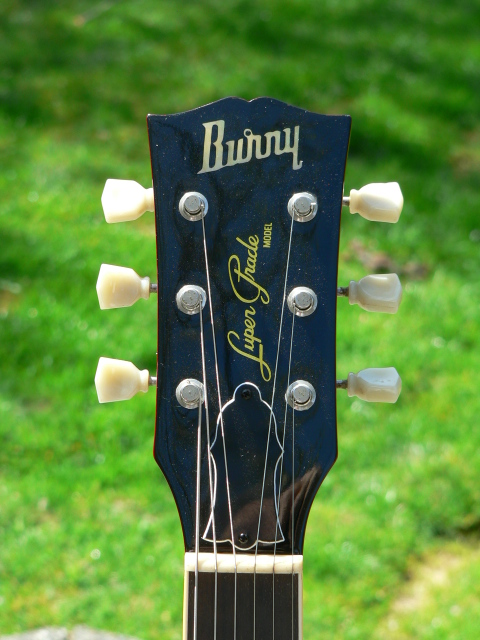 |
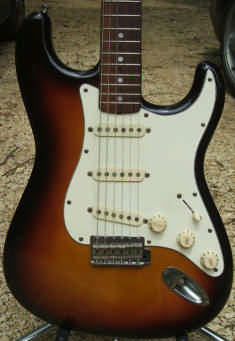 |
| 1988/89 FLG Low Script Wings |
1990-1996 FLG Normal Script Wings |
Pickups in detail
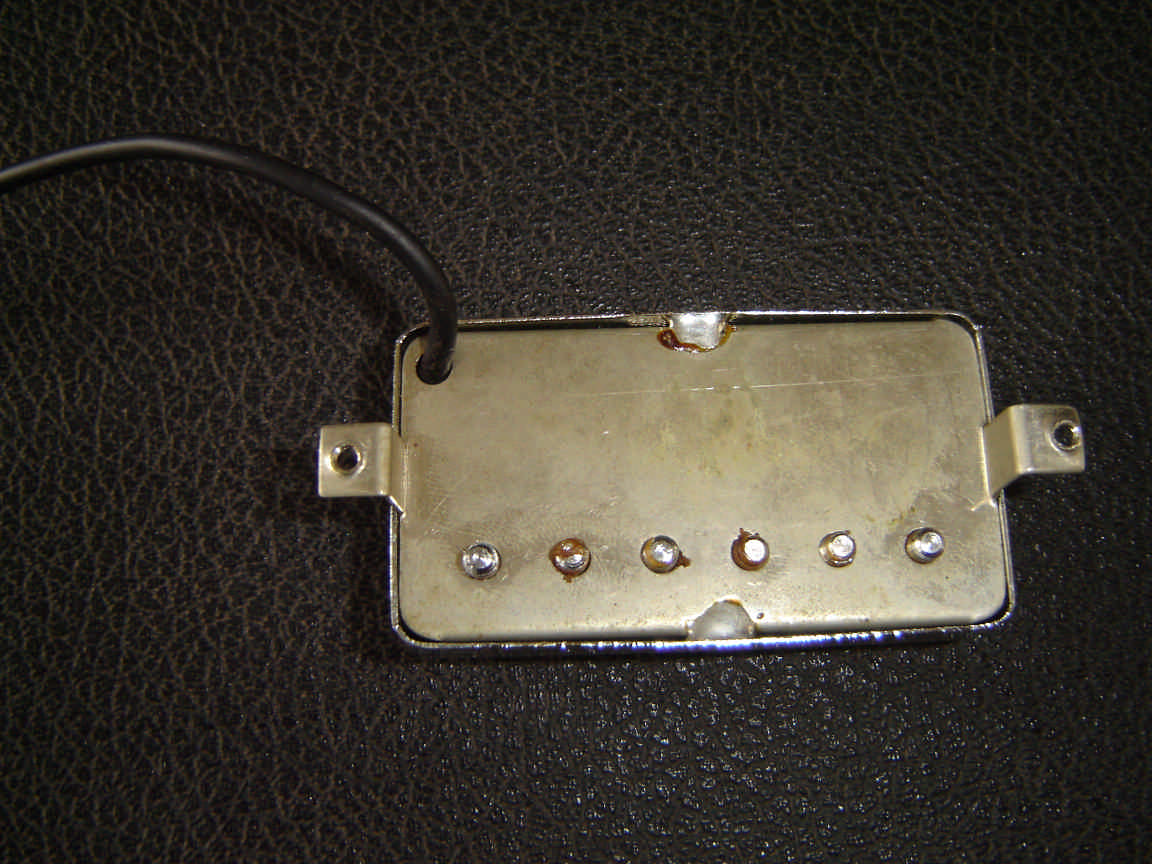
The pickup from a 1978 FLG 70. Note no screws to hold the bobbins.
Chrome covers. Front 7.40 ohms back 7.60 ohms. Different spacing of 6 adjustment screws
in front and back pickup. In the front pickup the spacing is 3 millimetres narrower.
Very wide pickup surrounds, not much like Gibsons.

The 1979 Tokai/Burny pickup (Gotoh PAF, All white bobbins and a chrome cover, metal coloured base plate and grey wire). Note the Tokai neck joint and the writing FLG 60 09 in the cavity.
PAF like 7,5- 7,6 ohms. Double white bobbins
Same pickup front and back. Correct size surrounds
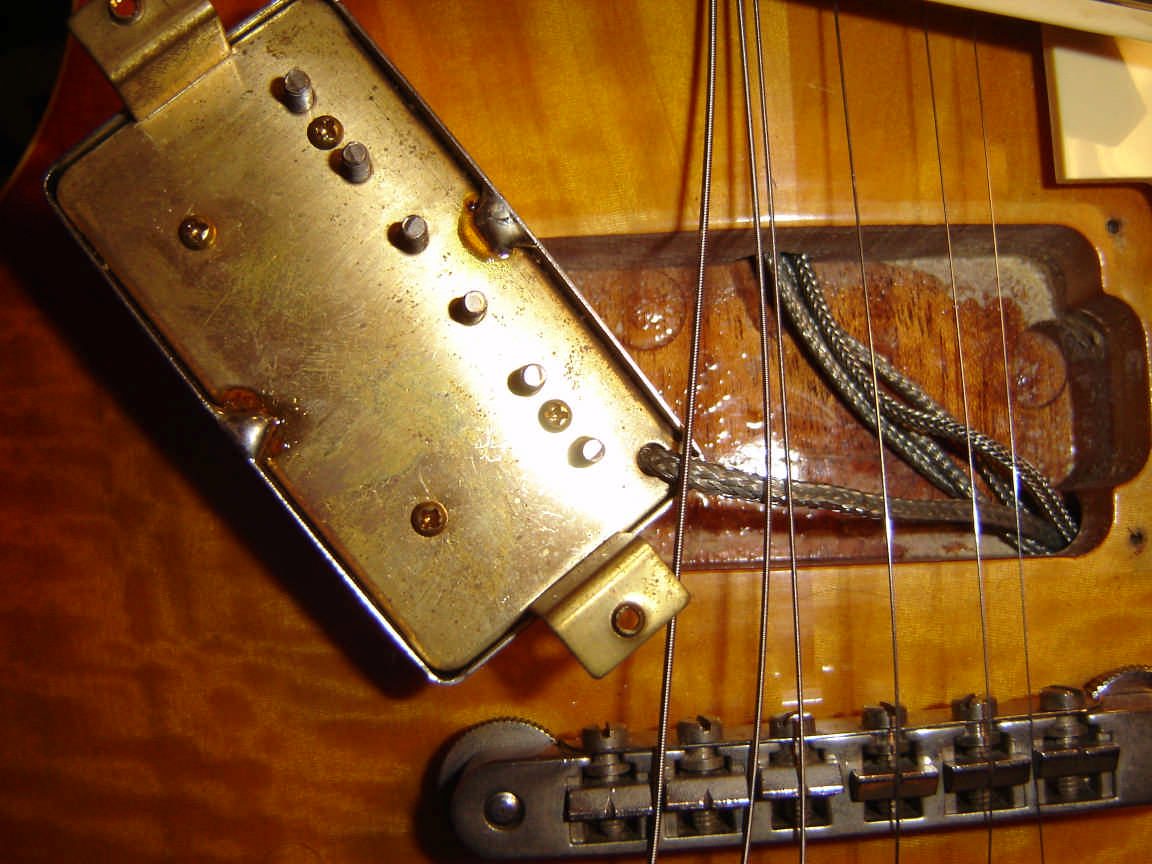
1981 L8001/8002 pick up , yellow coloured base plate, braided wire, 7,5-7,8 ohms
All black bobbins.
Surrounds not as high as on the original Gibsons, and with a rounded bottom.
Different screw spacing front/back
Nickel covers

1982-84 L8000 pickups now with grey wire, yellow base plate over 8.0 ohms.
Often black/white (zebra) bobbins
Different screw spacing and “correct” surrounds. Just a little wider than Gibsons (one millimetre)
Nickel covers on standards
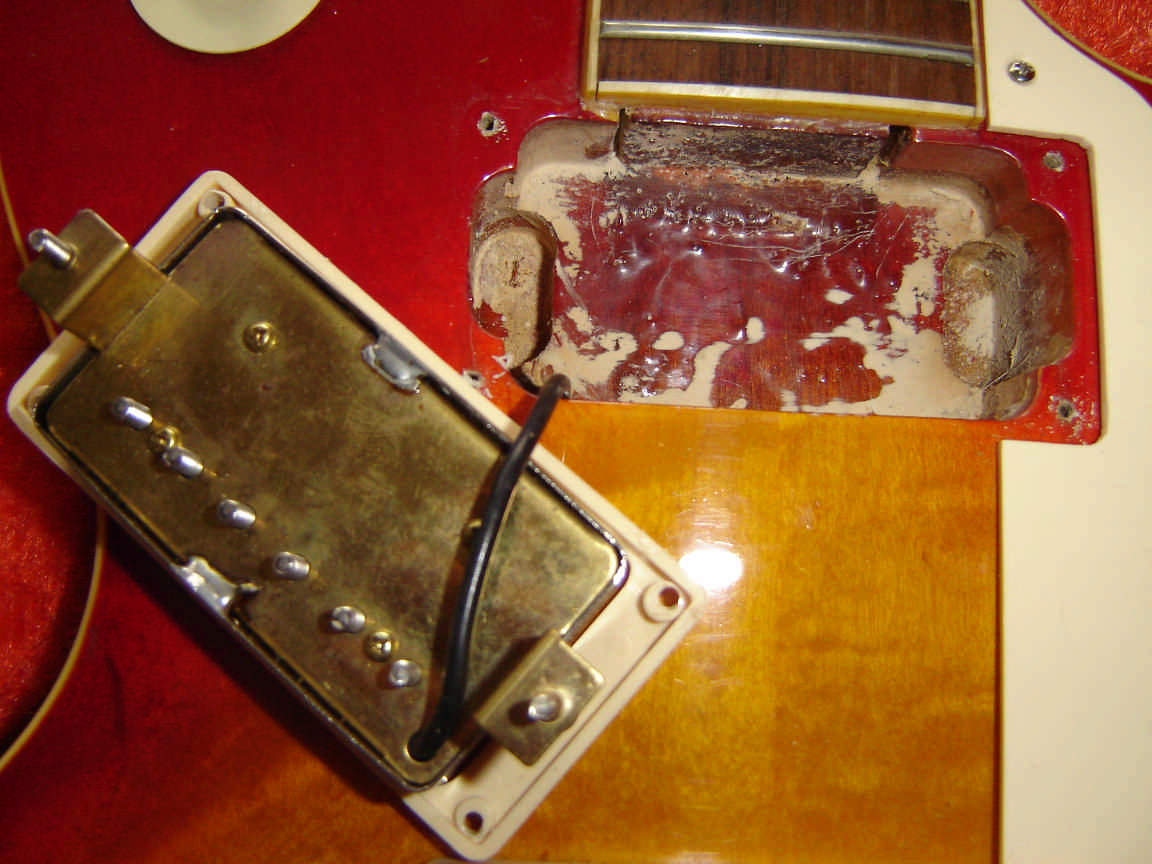
1984-87 VH4 pickup, black wire yellow base plate note typical neck joint from this period, to long joint just a lot of glue or something like it. 8.1 – 8.2 ohms. Different screw spacing and surrounds like the 82-84 pickup
Nickel covers on standards.
The VH1´s from this period looks the same, but with braided wire 7,5-7.8 ohms
The VH2´s probably have grey wire (I’m not sure). The VH2´s in my SA100 have grey wire and are over 8 ohms
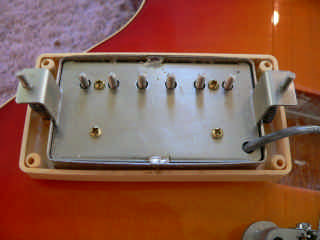
1989-1996 VH1 pickup. Metal coloured baseplate, grey wire high output
Surrounds as 82-87, but high adjustment screws Phillips headed and not slotted as on Gibsons and earlier Burnys.
8.40 front and 8.60 back. All black or Zebra bobbins. Nickel covers (gold) on Customs.
Electronics
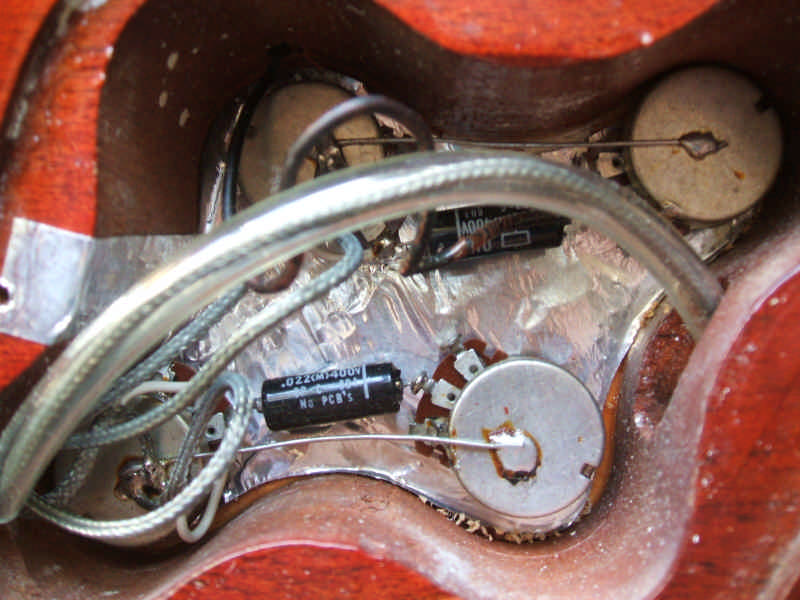
1980-83 FLG/RLG 90 and over electronics, note paper in oil capasitors and braided hook up wire.
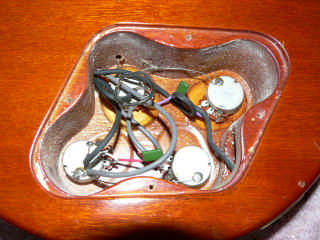
Typical 82-87 RLG 60-50 electronics. Plastic wire and small green capacitors.
After 1987-88 the capacitors was yellow
Serial numbers
All black bobbins.
Surrounds not as high as on the original Gibsons, and with a rounded bottom.
Different screw spacing front/back
Nickel covers

1982-84 L8000 pickups now with grey wire, yellow base plate over 8.0 ohms.
Often black/white (zebra) bobbins
Different screw spacing and “correct” surrounds. Just a little wider than Gibsons (one millimetre)
Nickel covers on standards

1984-87 VH4 pickup, black wire yellow base plate note typical neck joint from this period, to long joint just a lot of glue or something like it. 8.1 – 8.2 ohms. Different screw spacing and surrounds like the 82-84 pickup
Nickel covers on standards.
The VH1´s from this period looks the same, but with braided wire 7,5-7.8 ohms
The VH2´s probably have grey wire (I’m not sure). The VH2´s in my SA100 have grey wire and are over 8 ohms

1989-1996 VH1 pickup. Metal coloured baseplate, grey wire high output
Surrounds as 82-87, but high adjustment screws Phillips headed and not slotted as on Gibsons and earlier Burnys.
8.40 front and 8.60 back. All black or Zebra bobbins. Nickel covers (gold) on Customs.
Electronics

1980-83 FLG/RLG 90 and over electronics, note paper in oil capasitors and braided hook up wire.

Typical 82-87 RLG 60-50 electronics. Plastic wire and small green capacitors.
After 1987-88 the capacitors was yellow
Serial numbers
Up
until 1982 the FLG´s have serial numbers stamped on the back of
the headstock. The first cipher usually gives the manufacturing year.
From 1982 until 1990-92 no numbers then numbers again, but in the
pickup cavities (front or back)
80474 a 1978 FLG 70
8000437 a 1978 tokai number on a 1979 Burny FLG 60
03810 a 1980 FLG
00312 a 1980/81 FLG
44411 a 1994 RLG
51906 a 1996 RLG
80474 a 1978 FLG 70
8000437 a 1978 tokai number on a 1979 Burny FLG 60
03810 a 1980 FLG
00312 a 1980/81 FLG
44411 a 1994 RLG
51906 a 1996 RLG